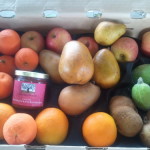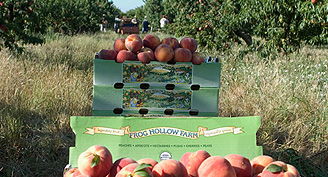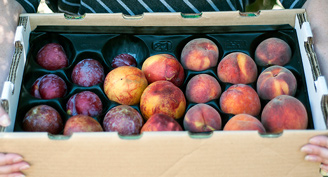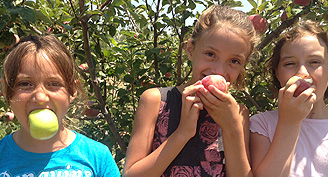In This Week's Box

[box_list]
[/box_list]
[print_this]
From Farmer Al
Greetings from the farm!
“Seasons Greetings” to all of you from all of us here on the farm!
For us, “tis the season” of cold, wet weather… Working in muddy soil to prune 25,000 trees, rake the prunings, trap gophers, and generally get the trees ready for the coming years crop. Our days begin cold and foggy and often we don’t see the sun for days on end due to the tule fog. But… we don’t mind one bit! Fog is a good thing around here. It’s what the trees need – “Winter Chill” translates to hours needed to properly develop their fruit buds for next years blossoms. We’re a little behind on the chilling hours required to set good buds (800 for cherries and 450 for peaches/apricots/nectarines). Chilling hours are tracked by hours of 45 degrees and under.
We have more great winter fruit for you this week… we hope you enjoy! We’ve also included a jar of one my favorite conserves—Nectarine Plum. Please visit us at www.happychildcsa.com for more information on the fruit.
So, here’s to hoping you all having a wonderful, healthy holiday season – and keep your fingers crossed for cold weather!
Organically Yours,

All About Feijoas
You might be wondering what those
funky, nubby, greenish-skinned fruits are. These are Feijoas (pronounced feh-JO-ah), also known as feijodas or pineapple guavas.
Named for a Brazilian botanist, they are native to the highland regions of southern Brazil, Uruguay, Paraguay, and northern Argentina.
Growing on tall evergreen shrubs with silvery bark and silver-green leaves, feijoas have also become a common California ornamental landscape tree. When ripe, a juicy slightly granular yellow pulp rings a center of clear, jelly-like seed pulp. The flavor is mild and tangy with hints of pineapple, kiwi, and guava. They're best eaten fresh - just slice them open lengthwise and scoop out the pulp with a spoon (the rind may be bitter).
Let them ripen at room temperature until the fruit gives a little when squeezed. Once ripe, store in the refrigerator.[/print_this]
Give Us Your Feedback
We depend on your weekly feedback.
Click here to take the survey.
 [box_list]
[box_list]








